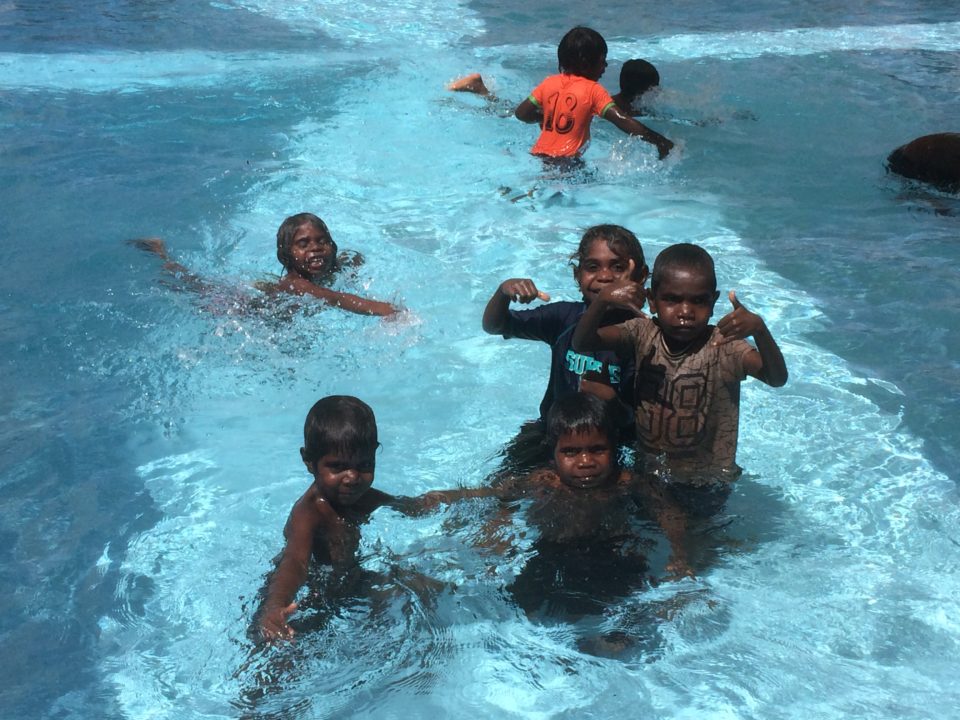Balgo, Western Australia, a remote Aboriginal community, located in the south-east Kimberley approximately 1100 miles NE of Perth and 560 miles SW of Darwin bordering the Great Sandy and Tanami Deserts and at the northern tip of the famous Canning Stock Route (think Wolf Creek).
For 9 months of the year the temperature rarely drops below 85 degrees – more often than not soaring well over 102 and Balgo doesn’t get much more “red-dirt-remote” or rough for the shifting population of around 460-600 indigenous people, relying on one gas station, a small convenience store, a School (K–8), Church, Art Centre, health clinic and an overworked police station. Substance abuse and unemployment in the remote community leads to higher than average rates of crime, domestic violence, child abuse, health issues and school delinquency. That was until the Balgo pool was built – an oasis of hope in the Australian outback.
In late September 2019, 200 people attended the much awaited opening of the new Balgo pool with a traditional Aboriginal ceremony of spiritual cleansing using branches to “sweep” the pool clean followed by the blessing of the pool by the local Priest who dipped a branch in a Coolamon – a traditional carved wooden bowl – of water, sprinkling it around the pool and buildings. With ceremonies complete, community elders explained the rules and then it was time for the fun to begin – to dive splash and frolic – rinsing off the red dust and oppressive heat.
The Balgo facility joins six others managed by Royal Life Saving across Western Australia. Staffed by Royal Life Saving pool managers who live in the community for 9 months of the year they provide swimming and water safety education, lifesaving skills, swim meets, birthday parties, after-school and holiday swimming and public lap swimming. Everything we take for granted as a normal part of life in Australia and even though it’s only for 9 months of the year, hopefully Australia will see more young, athletically gifted, indigenous swimmers encouraged to join in junior competitive swimming and aspire to represent their country at the highest level.
The pools also offer mentoring and training for community members with a view to management responsibility and ownership passing back to the community in the longer term. Pool lifeguard training course are offered and approximately 45 Aboriginal trainees have progressed to pool lifeguard standard – providing them with a highly portable job qualification for the future.
Balgo pool and the other Remote Aboriginal Swimming Pools are not just about swimming and being physically active they are a place where educational, health, well-being and social cohesion outcomes are achieved. Each community has embraced the “No School, No Pool” policy and school principals have reported a marked increase in school attendance and an overall improvement in the children’s behavior. With school attendance rates increasing from approximately 20% to 80% and police crediting the pools as definitely contributing to decreased crime in the town noting that during the swim season adolescent crime rates dropped to zero. It’s a SWIM-WIN situation.
The cost of the Balgo pool – $7 million – the value of the Balgo pool PRICELESS.

Perth ( WA) a city of 2 million hosted the World Champs twice in the 1990s . ( hello US ?????). In 2000 funds for comoetitive swimmig were diverted into providing the expanding indigenous communities with better chlirinated pools . Studies suggested regular use of higher chlorination could help reduce the chronic Glue Ear problem & results were almost immediate .
This is an extension of this program . WA also refunded & revitilised its competitive swimming from 2010 realising they could do both .
The FINA World Aquatics Championships encompass all the aquatic sports: pool swimming, diving, synchro, water polo, open water, and high diving. The facilities requirements are enormous, and no US city currently has all the facilities in place. Building temporary facilities is certainly an option, but that’s super expensive, and there aren’t always uses for the facilities after.
Consider the following facilities requirements. Perth was able to host the championships because of state-backed construction and continued funding for the main facility, Challenge Stadium. With THREE 50m pools and diving facilities, most of the facilities were already in place, and are still used constantly. Most hosts in the last 20 years either build a massive center (Budapest, Korea) or build temporary… Read more »
Tell me about it . I barely survived trying to jump off the boards! Some white Democrat threatened to strongarm me . And that was the lifeguard! .
Somewhat interestingly Australian aboriginal swimmers have a surprisingly good track record as age groupers and even a couple as open level swimmers. This is pretty unusual given the financial and time commitment required from swimmers and their families, when considering the other issues concerning that population.
Obviously this is secondary to the other benefits mentioned, but I’ve found it’s a sport they tend to be quite succesful in. It’s interesting.
What a brilliant result . Great article
Such a great initiative 🙂